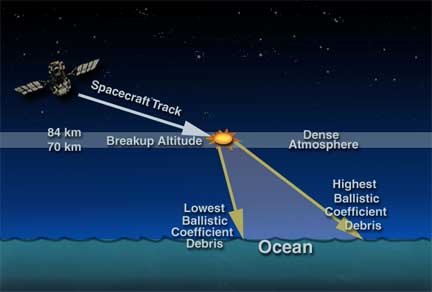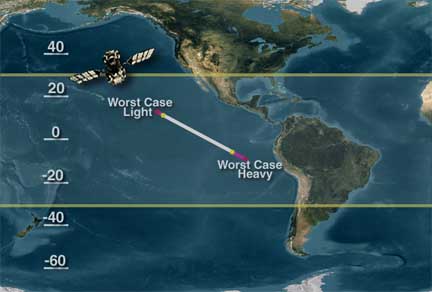Compton Gamma Ray Observatory De-orbit Status
After nine years of producing spectacular science that brought the field
of gamma-ray astronomy to its maturity, the Compton Gamma-Ray Observatory
will return to earth in a controlled reentry over the Pacific Ocean on
June 4.
The deorbit is taking place in four stages over the course of six days,
with each stage nudging the satellite a little more toward the earth's
atmosphere, where it will burn up and fall into the stretch of isolated
water roughly midway between Hawaii and the coast of South America.
The first stage took place on the evening of May 30. The satellite
controllers at Goddard Space Flight Center fired the thrusters on Compton,
which lowered the spacecraft's orbit from 510 kilometers to 364
kilometers. The second stage, or "firing," took place on the evening of
May 31. This lowered Compton to 250 kilometers above the earth.

|
|
This image shows that CGRO will hit the atmosphere at a steep angle,
dramatically slow down, break up, and fall into the ocean.
|
The third and forth stages will take place on June 4, only 90 minutes
apart in the early morning. The third burn will lower Compton to 150
kilometers, where it begins to encounter the atmosphere. The spacecraft
will heat up here, but all its controls will remain in working order. The
fourth burn will lower Compton to 80 kilometers. At this point, at 2:20
a.m. EDT, most of the 17-ton satellite will begin to burn up. Parts of
its frame and its titanium bolts, however, will remain intact and enter
the ocean a few moments later.

|
|
CGRO reentry footprint.
|
NASA made the decision to deorbit Compton after the failure of one of its
gyroscopes, a device used to steer the spacecraft. Although the satellite
was in full-working order, the failure of a second gyroscope would make it
more difficult to control the craft. Engineers lowered Compton while they
still had full control to ensure the safest possible reentry.
Additional Links
 Take me to the CGRO public information web site! (http://cossc.gsfc.nasa.gov/epo/index.html)
Take me to the CGRO public information web site! (http://cossc.gsfc.nasa.gov/epo/index.html)
| 